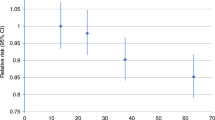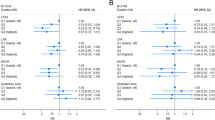Abstract
Epidemiologic studies suggest that physical activity reduces breast cancer risk by 20–40 %. However, prior studies have relied on measures of self-report. In a population-based case–control study, we evaluated accelerometer measures of active and sedentary behavior in relation to breast cancer among 996 incident cases and 1,164 controls, residents of Warsaw, Poland (2000–2003), who were asked to wear an accelerometer for 7 days. Accelerometer values were averaged across valid wear days and summarized as overall activity (counts [ct]/min/day); in minutes spent in sedentary behavior (0–99 ct/min); and light (100–759 ct/min) and moderate-to-vigorous (760+ ct/min) activity. Odds ratios (OR) and 95 % confidence intervals (CI) were estimated using unconditional logistic regression. Comparing women in the highest quartile (Q4) of activity to those in the lowest (Q1), time spent in moderate-to-vigorous activity was inversely associated with breast cancer odds after adjustment for known risk factors, sedentary behavior and wear time (ORQ4vsQ1 0.39, 95 % CI 0.27–0.56; P-trend < .0001). Sedentary time was positively associated with breast cancer, independent of moderate-to-vigorous activity (ORQ4vsQ1 1.81, 95 % CI 1.26-2.60; P-trend = 0.001). Light activity was not associated with breast cancer in multivariable models including both moderate-to-vigorous activity and sedentary behavior. Our findings support an inverse association between accelerometer-based measures of moderate-to-vigorous physical activity and breast cancer while also suggesting potential increases in risk with sedentary time.

Similar content being viewed by others
Abbreviations
- BMI:
-
Body mass index
- CI:
-
Confidence interval
- Ct:
-
Counts
- ER:
-
Estrogen receptor
- MV:
-
Multivariable
- NCI:
-
US National Cancer Institute
- OR:
-
Odds ratio
- PR:
-
Progesterone receptor
- Q:
-
Quartile
- SD:
-
Standard deviation
- PAM:
-
Physical activity monitor
References
Lynch BM, Neilson HK, Friedenreich CM (2011) Physical activity and breast cancer prevention. Recent Results Cancer Res 186:13–42. doi:10.1007/978-3-642-04231-7_2
Friedenreich CM (2011) Physical activity and breast cancer: review of the epidemiologic evidence and biologic mechanisms. Recent Results Cancer Res 188:125–139. doi:10.1007/978-3-642-10858-7_11
Monninkhof EM, Elias SG, Vlems FA, van der Tweel I, Schuit AJ, Voskuil DW, van Leeuwen FE (2007) Physical activity and breast cancer: a systematic review. Epidemiology 18(1):137–157. doi:10.1097/01.ede.0000251167.75581.98
Friedenreich CM, Neilson HK, Lynch BM (2010) State of the epidemiological evidence on physical activity and cancer prevention. Eur J Cancer 46(14):2593–2604. doi:10.1016/j.ejca.2010.07.028
George SM, Irwin ML, Matthews CE, Mayne ST, Gail MH, Moore SC, Albanes D, Ballard-Barbash R, Hollenbeck AR, Schatzkin A, Leitzmann MF (2010) Beyond recreational physical activity: examining occupational and household activity, transportation activity, and sedentary behavior in relation to postmenopausal breast cancer risk. Am J Public Health 100(11):2288–2295. doi:10.2105/AJPH.2009.180828
Mathew A, Gajalakshmi V, Rajan B, Kanimozhi VC, Brennan P, Binukumar BP, Boffetta P (2009) Physical activity levels among urban and rural women in south India and the risk of breast cancer: a case-control study. Eur J Cancer Prev 18(5):368–376. doi:10.1097/Cej.0b013e32832e1c46
Owen N, Healy GN, Matthews CE, Dunstan DW (2010) Too much sitting: the population health science of sedentary behavior. Exerc Sport Sci Rev 38(3):105–113. doi:10.1097/JES.0b013e3181e373a2
Ford ES, Li C, Zhao G, Pearson WS, Tsai J, Churilla JR (2010) Sedentary behavior, physical activity, and concentrations of insulin among US adults. Metabolism 59(9):1268–1275. doi:10.1016/j.metabol.2009.11.020
Lynch BM, Friedenreich CM, Winkler EA, Healy GN, Vallance JK, Eakin EG, Owen N (2011) Associations of objectively assessed physical activity and sedentary time with biomarkers of breast cancer risk in postmenopausal women: findings from NHANES (2003–2006). Breast Cancer Res Treat. doi:10.1007/s10549-011-1559-2
Ford ES, Kohl HW, III, Mokdad AH, Ajani UA (2005) Sedentary behavior, physical activity, and the metabolic syndrome among U.S. adults. Obes Res 13(3):608–614. doi:10.1038/oby.2005.65
Healy GN, Matthews CE, Dunstan DW, Winkler EA, Owen N (2011) Sedentary time and cardio-metabolic biomarkers in US adults: NHANES 2003–06. Eur Heart J 32(5):590–597. doi:10.1093/eurheartj/ehq451
Neilson HK, Friedenreich CM, Brockton NT, Millikan RC (2009) Physical activity and postmenopausal breast cancer: proposed biologic mechanisms and areas for future research. Cancer Epidemiol Biomarkers Prev 18(1):11–27. doi:10.1158/1055-9965.EPI-08-0756
Peplonska B, Lissowska J, Hartman TJ, Szeszenia-Dabrowska N, Blair A, Zatonski W, Sherman ME, Garcia-Closas M, Brinton LA (2008) Adulthood lifetime physical activity and breast cancer. Epidemiology 19(2):226–236. doi:10.1097/EDE.0b013e3181633bfb
Garcia-Closas M, Brinton LA, Lissowska J, Chatterjee N, Peplonska B, Anderson WF, Szeszenia-Dabrowska N, Bardin-Mikolajczak A, Zatonski W, Blair A, Kalaylioglu Z, Rymkiewicz G, Mazepa-Sikora D, Kordek R, Lukaszek S, Sherman ME (2006) Established breast cancer risk factors by clinically important tumour characteristics. Br J Cancer 95(1):123–129. doi:10.1038/sj.bjc.6603207
Matthews CE (2005) Calibration of accelerometer output for adults. Med Sci Sports Exerc 37(11):S512–S522
Matthews CE, Chen KY, Freedson PS, Buchowski MS, Beech BM, Pate RR, Troiano RP (2008) Amount of time spent in sedentary behaviors in the United States, 2003–2004. Am J Epidemiol 167(7):875–881. doi:10.1093/aje/kwm390
Begg CB, Zhang ZF (1994) Statistical analysis of molecular epidemiology studies employing case-series. Cancer Epidemiol Biomarkers Prev 3(2):173–175
Patel AV, Bernstein L, Deka A, Feigelson HS, Campbell PT, Gapstur SM, Colditz GA, Thun MJ (2010) Leisure time spent sitting in relation to total mortality in a prospective cohort of US adults. Am J Epidemiol 172(4):419–429. doi:10.1093/aje/kwq155
Healy GN, Dunstan DW, Salmon J, Shaw JE, Zimmet PZ, Owen N (2008) Television time and continuous metabolic risk in physically active adults. Med Sci Sports Exerc 40(4):639–645. doi:10.1249/MSS.0b013e3181607421
Lynch BM (2010) Sedentary behavior and cancer: a systematic review of the literature and proposed biological mechanisms. Cancer Epidemiol Biomarkers Prev 19(11):2691–2709. doi:10.1158/1055-9965.EPI-10-0815
Lynch BM, Dunstan DW, Healy GN, Winkler E, Eakin E, Owen N (2010) Objectively measured physical activity and sedentary time of breast cancer survivors, and associations with adiposity: findings from NHANES (2003–2006). Cancer Causes Control 21(2):283–288. doi:10.1007/s10552-009-9460-6
Friedenreich CM, Cust AE (2008) Physical activity and breast cancer risk: impact of timing, type and dose of activity and population subgroup effects. Br J Sports Med 42(8):636–647. doi:10.1136/bjsm.2006.029132
Irwin ML, Crumley D, McTiernan A, Bernstein L, Baumgartner R, Gilliland FD, Kriska A, Ballard-Barbash R (2003) Physical activity levels before and after a diagnosis of breast carcinoma—the health, eating, activity, and lifestyle (HEAL) study. Cancer 97(7):1746–1757. doi:10.1002/Cncr.11227
Kushi LH, Byers T, Doyle C, Bandera EV, McCullough M, McTiernan A, Gansler T, Andrews KS, Thun MJ (2006) American Cancer Society Guidelines on Nutrition and Physical Activity for cancer prevention: reducing the risk of cancer with healthy food choices and physical activity. CA Cancer J Clin 56(5):254–281 quiz 313–254
Vainio H, Kaaks R, Bianchini F (2002) Weight control and physical activity in cancer prevention: international evaluation of the evidence. Eur J Cancer Prev 11(Suppl 2):S94–S100
Acknowledgments
We thank Michael Stagner and Pei Chao for their work on study and data management (IMS, Silver Spring, MD); physicians, pathologists, nurses, and interviewers from participating centers in Poland for their efforts in the field. We also thank the participants of the Polish Study for their contributions to this study, Dr. Bill Anderson for his statistical consultation, Dr. Mark Sherman for his independent evaluation of histopathological information, and Drs. Montserrat Garcia-Closas and Mark Sherman for contributions to study design. Polish Breast Cancer Study was supported by the Intramural Research Program of the National Cancer Institute, Department of Health and Human Services, USA. Participating centers in Poland: Cancer Center and M. Sklodowska-Curie Institute of Oncology in Warsaw Departments of Epidemiology (Coordinating center: Dr Jolanta Lissowska, Mrs Alicja Bardin-Mikolajczak, and Dr Witold Zatonski), Breast Cancer Treatment and Reconstruction (Drs Edward Towpik and Jerzy Giermek), Departments of Surgical Oncology (Dr Pawel Kukawski), and Pathology (Drs Grzegorz Rymkiewicz, Marcin Ligaj, Joanna Baran′ska, Agnieszka Turowicz, and Włodzimierz Olszewski). Polish Oncological Foundation in Warsaw Pathology (Drs Dorota Mazepa-Sikora, Włodzimierz Olszewski). Nofer Institute of Occupational Medicine in Łόdz′ (Drs Neonila Szeszenia-Da˛browska, Beata Peplonska). Medical University in Łόdz′ Oncology Clinic (Drs Arkadiusz Jeziorski, Janusz Piekarski), and Pathology Department (Drs Radzislaw Kordek, Grazyna Pasz-Walczak, Robert Kubiak, Dorota Kupnicka, Boguslaw Olborski). Community Copernicus Hospital in Łόdz′ Department of Surgical Oncology (Drs Zbigniew Morawiec and Mariusz Pawlak). Polish Mother’s Health Memorial Hospital in Łόdz′ Departments of Surgical Oncology and Breast Diseases (Drs Marcin Faflik, Magdalena Baklinska, Marek Zadrozny, Boguslaw Westfal) and Clinical Pathomorphology (Drs Stanislaw Lukaszek, Andrzej Kulig).
Conflict of interest
The authors declare they have no conflicts of interest.
Author information
Authors and Affiliations
Corresponding author
Electronic supplementary material
Below is the link to the electronic supplementary material.
Rights and permissions
About this article
Cite this article
Dallal, C.M., Brinton, L.A., Matthews, C.E. et al. Accelerometer-based measures of active and sedentary behavior in relation to breast cancer risk. Breast Cancer Res Treat 134, 1279–1290 (2012). https://doi.org/10.1007/s10549-012-2129-y
Received:
Accepted:
Published:
Issue Date:
DOI: https://doi.org/10.1007/s10549-012-2129-y




